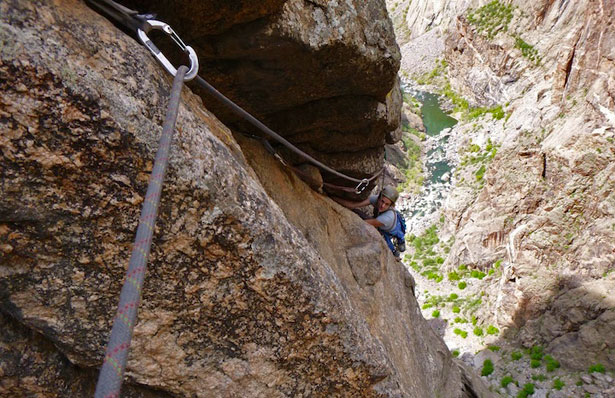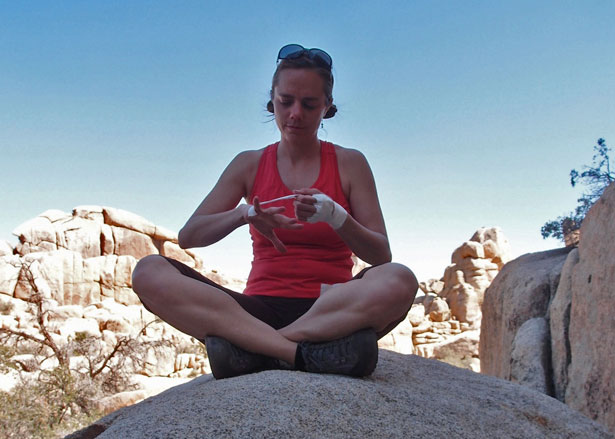The Making of a Leader

Mandi Franz follows the Vector Traverse on Escape Artist (5.9) in the Black Canyon of the Gunnison, 2013.
On a good day, my wife might lead a short pitch of 5.8 trad or a 5.10 sport climb. However, she almost never has to do anything she doesn’t want to when we go climbing, be it leading or even finishing a pitch to clean the anchors. That’s because I can almost always take care of everything in no time at all. Almost.
The roles were reversed on a trip to Moab this last Thanksgiving. I’m recovering from a broken ankle that happened in the Black Canyon Sept. 25. Any climbing I did would have to be in a plastic, knee-high cast at a roadside crag called Wall Street. Obviously, the only safe way to climb would be on toprope. Mandi would have to be the rope gun.
You might ask, why climb at all? That is a silly question. Even if you’re not a climber, you would understand if you had endured the previous two months with me cooped up on the couch. Mandi enjoys climbing but she can easily go without it. Even she couldn’t bear the thought of me going another month without some rock. Like our dog incessantly whining for an overdue walk, there was only one way for any of us to regain sanity, and that was to get me out of the house and off the ground. Otherwise our liquor budget was likely to blow through the roof like the geyser of Old Faithful.
So there we were, parked along Potash Road on the Tuesday before Thanksgiving. Just breathing the crisp breeze from the Colorado River at the base of a sunny desert wall was rejuvenating.
We found a bolted sandstone arête – a 5.8 slab that required complete trust in some blank foot smears as you moved between handholds. Mandi had pranced up this route in the past but never led it. The first 15 feet are unprotected to the first bolt, above some jumbled boulders: a definite no-fall zone.
Mandi had not climbed at all since the end of August, and it had been much longer than that since she had to deal with a no-fall situation. She handled it beautifully, not rushing any of the moves, and only moving when she was sure of herself.
I felt like an anxious father must feel when it’s time to let his kid spread her wings. I had always been the protector and now she was on her own. The most I could do was offer advice when she asked for it, and give her the best possible belay. I didn’t want to scare her by repeatedly pointing out the worst-case scenarios, and I didn’t want her to neglect potential consequences, either. Mostly, I didn’t want my nervous energy to cloud her performance. Mandi grabbed a quickdraw at one point, but she got up the route safely.
A young man who was climbing with us failed to get up the route after two tries, and it reframed my perspective on what I usually take for granted. (Our friend had only bouldered in the gym before, so slab climbing was still a mystery to him.) I hiked the climb in a cast, though I bruised my right knee by scumming it on the slab in lieu of my foot.
Next we scored a toprope on a crumbly 5.9+ offwidth, after I loaned some big cams to a young guy who had never sampled an Oh-Dub before. His girlfriend was new to belaying, and we tried not to watch as the duo labored up the route, knocking off rocks and learning much along the way. At last our TR was up, and Mandi sent first go, as did I. If there’s one time a large plastic boot can be an advantage, it’s jamming a wide crack. The boot got stuck a couple times, and I had to laugh at myself.
To finish the day, Mandi put a toprope on a bolted 5.10 face by leading a runout slab to the left. She did great. I enjoyed watching her take the lead as much as I enjoyed the climbing.
Our second day out came to a head on Thanksgiving, when all the potential routes Mandi might lead were occupied except for one spicy 5.8 corner with two bolts in the top section. The start was protected by small wires above a ledge and a boulder: another no-fall zone. She could only place one tiny wired nut before committing to a layback and sprinting to a pod where the crack finally opened enough to place some real gear.
For me it was a flashback to the situation that resulted in my broken ankle, when a nut blew out of a crack in the Black Canyon.
“You don’t have to do this,” I pleaded. Mandi was nervous, but she wanted to try. Who was I to tell her no? To understand the soul of climbing is to know what it’s like to test your limits in a scary situation.
Mandi committed and reached the pod. Her arms were pumping out as she hung from the pod and raced to place gear. She fired in a green cam on her second try.
No! You’re going to need that higher up, I thought. But I didn’t say anything. The immediate priority was getting some pro that would keep her off the ground.
Several cam placements later, the crack pinched off and it was going to be another layback sprint to reach the first bolt. Mandi discovered she needed a cam that was no longer on her harness. After some debate, she lowered down, got the cam, and tried again. She climbed up and down a few times with the last cam at her feet, but by then she was too fried to go for it.
Ultimately, she didn’t finish the lead, but that’s not the point. Mandi was determined and able to perform, in spite of her fear. Though not as efficient as a honed leader, she exhibited coolness under duress. She was patient enough to make sound decisions and place good gear while taking a bit of mandatory risk. And in the end, she had the courage to back off in the midst of a small crowd that was waiting to climb (she had the courage to make an unpopular decision). Those are all the elements of a leader, which any climber must learn to become if he or she is ever to earn the fabled title of “Rope Gun.”
No matter how hard you climb, if you have ever been afraid and climbed upward anyway, sometimes with success and sometimes to the point of retreat, you know what it is to be a climber.
Derek Franz writes a blog for SplitterChoss.com once a month. Visit derekfranz.com for more of his writing and photos.
Bulldog Creek Dog Walk (IV WI 4+)
Hayden Carpenter and Tom Bohanon recently repeated an obscure ice climb on the south side of Mt Sopris. Given a brief mention in Jack Robert’s ice guide, Bulldog Creek Walk is described as being 100 meters of WI 4. What they found was seven pitches of ice in a remote setting that makes for one […]
Connect with Us
















Recent Comments